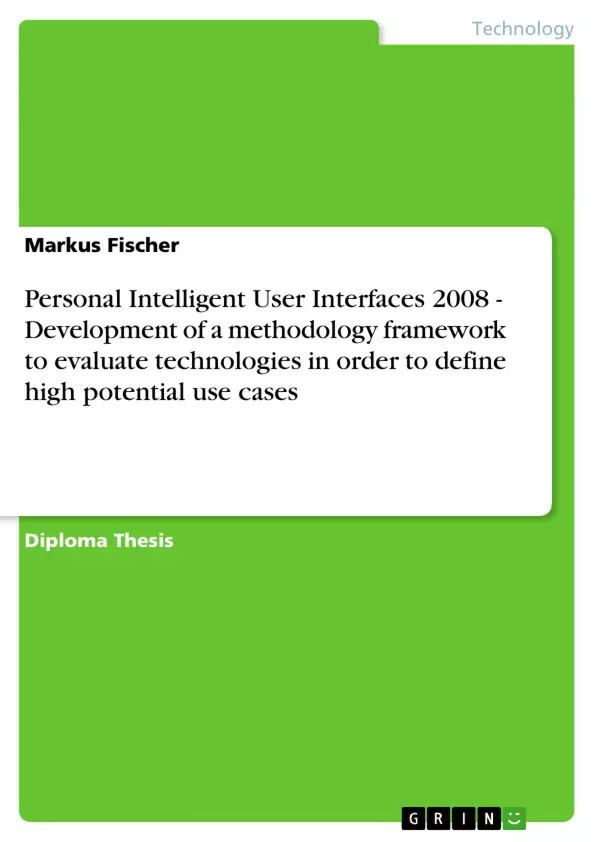Germany depends heavily on the only raw material available within its national territoryknowledge. Nevertheless, major management faults due to a lack of management knowledge have led to closures of prosperous companies and in many cases to layoffs in the thousands in the recent past. This questions the abilities of companies and their decision makers and, once again, the actual quality of our most precious good. Managers cannot talk themselves out of this by stating that Germany is no longer able to produce competitively, as this is not true. The challenge is to make products people both need and enjoy. To achieve this goal, this thesis provides a tailored solution for the information and communication market.
The topic deals with one of the most promising technologies since the internet, namely the next generation of user interfaces - personal intelligent user interfaces (PIUIs). Some call it the Pan-dora’s Box of the information century, whereas others consider it to be the salvation for the mobile generation. This thesis might not be able to give a final answer to this dispute but provides a toolkit for the strategic technology management to cope with new technologies. Fur-thermore, a methodology framework is developed and applied to evaluate the usability of intelligent user interfaces. Usability isthekey factor for broad user acceptance and success in a highly competitive market environment like the communication sector. Beyond that, the work presents a list of high potential use cases for PIUIs till 2008. First “products” of this list have been presented or even rolled out earlier this year by major ICT companies like Nokia and Microsoft. This proof of validity and the fact that this paper includes a comprehensive list of indepth analysed next generation user interface technologies make this work a must read for every determined and responsible manager.
Inhaltsverzeichnis (Table of Contents)
- Abstract
- Kurzfassung
- Table of Contends
- Introduction
- Scenario
- Problem Setting and Goals
- Structural Overview of the Thesis
- Delimitation and Conceptual Definitions
- Strategic Technology Management
- Methods of Strategic Technology Management
- Technology Forecasting
- Expert Panel
- Scanning and Monitoring
- Patent and Literature Analysis
- Trend Impact Analysis
- Gap Analysis
- Scenario Analysis
- The Gardner Hype Cycle
- Technology Assessment
- Personal Intelligent User Interface
- Definition Human-Computer Interaction
- Definition of User Interface
- Definition of Intelligent User Interface
- Definition of Personal Intelligent User Interfaces
- Development of the user requirement framework
- Usability
- Analysis of existing usability standards
- The technology user requirements framework
- Use case development
- User interfaces and technologies
- Affective Computing
- Virtual Reality
- Mixed Reality - Augmented Reality
- Chip Implants for Identification
- Brain-Computer Interface
- Electronic Ink and Digital Paper
- Displays
- Retinal Displays
- Gaze Tracking
- Gesture Recognition
- Handwriting
- Handwriting Capture
- Natural Handwriting Recognition
- Haptic Interfaces
- Intelligent Agents
- Location Sensing
- Machine Translation
- Natural Language Search
- Speech Recognition
- Speech-to-Speech Translation
- Synthetic Characters
- Telepresence
- Text-to-Speech Synthesis
- Wearable Computers
- Conclusion
- Summary
- Outlook
Zielsetzung und Themenschwerpunkte (Objectives and Key Themes)
This thesis focuses on the development of a methodology framework for evaluating technologies in order to define high-potential use cases for Personal Intelligent User Interfaces (PIUIs). The work aims to provide a solution for strategic technology management within the information and communication market. It investigates the usability of intelligent user interfaces as a key factor for user acceptance and success.
- Strategic Technology Management
- Usability of Intelligent User Interfaces
- Personal Intelligent User Interfaces (PIUIs)
- High-potential Use Cases for PIUIs
- Methodology Framework for Evaluating Technologies
Zusammenfassung der Kapitel (Chapter Summaries)
- Introduction: This chapter sets the scene, outlining the current scenario in the information and communication market, highlighting the importance of knowledge as a resource, and introducing the problem setting and goals of the thesis. It also provides a structural overview of the work.
- Delimitation and Conceptual Definitions: This chapter delves into the concepts of Strategic Technology Management and its various methods, including technology forecasting techniques like expert panels, scanning and monitoring, patent analysis, and scenario analysis. It also introduces the Gartner Hype Cycle and the concept of Technology Assessment. Furthermore, it provides definitions for Human-Computer Interaction, User Interface, Intelligent User Interface, and Personal Intelligent User Interface.
- Development of the user requirement framework: This chapter explores the concept of usability and analyzes existing usability standards. It outlines the development of the technology user requirements framework and its application in use case development.
- User interfaces and technologies: This chapter presents a comprehensive overview of various user interface technologies, including affective computing, virtual reality, mixed reality, chip implants, brain-computer interfaces, electronic ink, displays, gaze tracking, gesture recognition, handwriting recognition, haptic interfaces, intelligent agents, location sensing, machine translation, natural language search, speech recognition, speech-to-speech translation, synthetic characters, telepresence, text-to-speech synthesis, and wearable computers.
Schlüsselwörter (Keywords)
The key focus of this thesis lies in the development and application of a methodology framework for evaluating technologies related to Personal Intelligent User Interfaces (PIUIs). Key terms include strategic technology management, usability, intelligent user interfaces, high-potential use cases, and a comprehensive analysis of next-generation user interface technologies.
- Citar trabajo
- Dipl. Ing. (FH) Markus Fischer (Autor), 2006, Personal Intelligent User Interfaces 2008 - Development of a methodology framework to evaluate technologies in order to define high potential use cases, Múnich, GRIN Verlag, https://www.grin.com/document/70633



